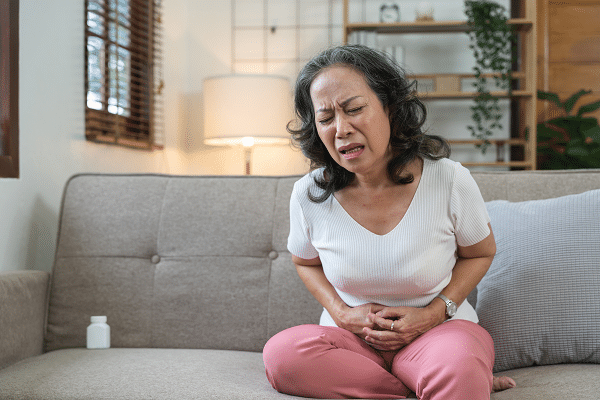Understanding the causes of upper abdominal pain can be a crucial step in identifying potential emergencies that require immediate medical attention. Severe discomfort in this area is not to be dismissed, as it could indicate a myriad of conditions, some of which are potentially life-threatening. This blog post explores common conditions that could lead to severe upper abdominal pain, namely bowel obstruction, gallstones, and pancreatitis. Each of these conditions will be examined in terms of their symptoms, risks, and the need for prompt intervention.
Bowel Obstruction
Bowel obstruction is a medical emergency characterized by a blockage in the intestines, which inhibits the passage of food, fluids, and gas. This obstruction can result in intense pain in the upper abdomen, accompanied by nausea, vomiting, and inability to pass gas or bowel movements. Left untreated, it can cause severe complications such as tissue death due to reduced blood flow to the intestines or even perforation of the intestinal wall, leading to life-threatening infection.
Diagnosis of bowel obstruction often involves imaging tests like X-rays or CT scans, while treatment ranges from supportive care with intravenous fluids and a nasogastric tube to surgery, depending on the severity of the blockage. The key takeaway here is the importance of timely intervention. Delay in treatment can escalate the situation from a manageable condition to a serious health crisis.
Gallstones
Gallstones are hard particles that develop in the gallbladder, a small organ under the liver responsible for storing bile. The most common type of gallstones are cholesterol stones, which form when there’s too much cholesterol in the bile. Sometimes, these stones can block the bile ducts leading out of the gallbladder, causing sharp, intense pain in the upper right part of the abdomen, referred to as a gallbladder attack.
Although gallstones are relatively common and often asymptomatic, they can lead to serious complications if the blockage persists. These can include inflammation and infection of the gallbladder (cholecystitis), inflammation of the pancreas (pancreatitis), and infection of the bile ducts (cholangitis). These conditions can be life-threatening if not treated promptly. Treatment for symptomatic gallstones often involves surgical removal of the gallbladder, a common procedure known as cholecystectomy.
Pancreatitis
Pancreatitis refers to inflammation of the pancreas, an organ responsible for producing enzymes that aid digestion and hormones that regulate the way the body processes sugar. It can cause severe upper abdominal pain, which typically worsens after eating and radiates to the back. Other symptoms may include fever, rapid pulse, nausea, and vomiting.
Pancreatitis can be acute, occurring suddenly and lasting for days, or chronic, occurring over many years. Both types can have serious complications. Acute pancreatitis can cause kidney failure or even a life-threatening systemic infection. Chronic pancreatitis can lead to malnutrition due to the pancreas not producing enough digestive enzymes, or diabetes, due to damage to insulin-producing cells. Both conditions underscore the need for early diagnosis and intervention, as effective management can prevent further damage and control pain.
Crohn’s Disease
Crohn’s disease is an inflammatory bowel disease that often leads to severe discomfort in various regions of the digestive tract, including the upper abdomen. This chronic condition is characterized by periods of remission interspersed with episodes of severe symptoms. The pain associated with Crohn’s disease typically stems from inflammation and ulceration within the digestive tract, which can lead to complications such as strictures or obstructions.
Neglecting the pain associated with Crohn’s disease can have serious repercussions. Persistent inflammation can lead to nutritional deficiencies, anemia, and severe fatigue, among other complications. Furthermore, the inflammation can occasionally spread to affect other areas of the body, including the skin, eyes, and joints. Therefore, persistent or severe upper abdominal pain could be a sign of an active Crohn’s disease flare and should prompt immediate medical attention to initiate appropriate management and prevent further complications.
Heart Attack
Upper abdominal pain might also be a sign of a heart attack. Sometimes, instead of classic symptoms like chest pain or tightness, a heart attack can present with abdominal discomfort, often described as epigastric (upper abdominal) pain or indigestion. Other symptoms can include shortness of breath, lightheadedness, and cold sweats.
Given that heart attacks can be fatal, it is crucial to recognize these symptoms and seek immediate medical help. Time is of the essence in treating heart attacks; the quicker one receives treatment, the better the chances of survival and recovery. Any unusual upper abdominal pain that persists or is accompanied by other symptoms such as breathlessness or excessive sweating should be considered a medical emergency.
Liver Abscesses
Liver abscesses, pockets of pus in the liver, can also cause upper abdominal pain. These abscesses can form due to a variety of reasons, including bacterial infection, parasitic infection, or following injury or surgery to the liver. Along with abdominal pain, symptoms can include fever, loss of appetite, weight loss, and jaundice (a yellowing of the skin and eyes).
Prompt diagnosis and treatment of liver abscesses are vital, as delays can lead to serious complications, including the spread of infection to other parts of the body and potentially life-threatening sepsis. Treatment typically involves antibiotics to clear the infection and, in some cases, drainage of the abscess. It is crucial that any suspicion of liver abscesses be taken seriously and that medical attention be sought promptly.
Diverticular Disease
Diverticular disease refers to conditions that occur when small pouches, or diverticula, form and push outward through weak spots in the wall of the colon, or large intestine. Diverticulosis, the formation of these pouches, can cause pain in the abdomen, though many people experience no symptoms. When these pouches become inflamed or infected, a condition known as diverticulitis, it can result in severe abdominal pain, typically on the lower left side, but it may also present as upper abdominal pain.
Failure to treat diverticulitis can lead to serious complications, such as the formation of an abscess, perforation of the colon, or peritonitis (a widespread infection in the abdomen). This can result in severe, potentially life-threatening situations. Therefore, timely diagnosis and treatment are critical in managing diverticular disease effectively. Treatment often involves antibiotics and, in more severe cases, may require hospitalization or surgery.
Conclusion
Recognizing the importance of upper abdominal pain as a potential emergency and seeking timely medical intervention is essential. This blog post has highlighted several conditions that might lead to such pain, including bowel obstruction, gallstones, pancreatitis, crohn’s disease, heart attacks, liver abscesses, and diverticular disease. Each of these conditions underscores the critical importance of not dismissing unexplained or severe pain in the upper abdomen. Remember, early diagnosis often results in better treatment outcomes and can even be lifesaving. Therefore, do not hesitate to seek medical help if experiencing such discomfort.






